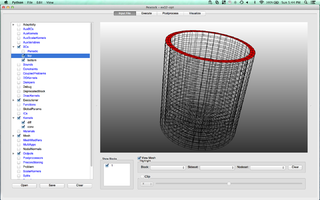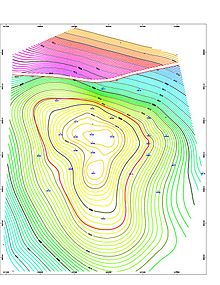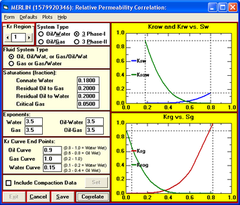
Petroleum engineering is a field of engineering concerned with the activities related to the production of Hydrocarbons, which can be either crude oil or natural gas. Exploration and production are deemed to fall within the upstream sector of the oil and gas industry. Exploration, by earth scientists, and petroleum engineering are the oil and gas industry's two main subsurface disciplines, which focus on maximizing economic recovery of hydrocarbons from subsurface reservoirs. Petroleum geology and geophysics focus on provision of a static description of the hydrocarbon reservoir rock, while petroleum engineering focuses on estimation of the recoverable volume of this resource using a detailed understanding of the physical behavior of oil, water and gas within porous rock at very high pressure.

Computational fluid dynamics (CFD) is a branch of fluid mechanics that uses numerical analysis and data structures to analyze and solve problems that involve fluid flows. Computers are used to perform the calculations required to simulate the free-stream flow of the fluid, and the interaction of the fluid with surfaces defined by boundary conditions. With high-speed supercomputers, better solutions can be achieved, and are often required to solve the largest and most complex problems. Ongoing research yields software that improves the accuracy and speed of complex simulation scenarios such as transonic or turbulent flows. Initial validation of such software is typically performed using experimental apparatus such as wind tunnels. In addition, previously performed analytical or empirical analysis of a particular problem can be used for comparison. A final validation is often performed using full-scale testing, such as flight tests.

Hydrogeology is the area of geology that deals with the distribution and movement of groundwater in the soil and rocks of the Earth's crust. The terms groundwater hydrology, geohydrology, and hydrogeology are often used interchangeably.
Permeability in fluid mechanics and the Earth sciences is a measure of the ability of a porous material to allow fluids to pass through it.
Darcy's law is an equation that describes the flow of a fluid through a porous medium. The law was formulated by Henry Darcy based on results of experiments on the flow of water through beds of sand, forming the basis of hydrogeology, a branch of earth sciences. It is analogous to Ohm's law in electrostatics, linearly relating the volume flow rate of the fluid to the hydraulic head difference via the hydraulic conductivity.
In fluid statics, capillary pressure is the pressure between two immiscible fluids in a thin tube, resulting from the interactions of forces between the fluids and solid walls of the tube. Capillary pressure can serve as both an opposing or driving force for fluid transport and is a significant property for research and industrial purposes. It is also observed in natural phenomena.

In fluid mechanics, multiphase flow is the simultaneous flow of materials with two or more thermodynamic phases. Virtually all processing technologies from cavitating pumps and turbines to paper-making and the construction of plastics involve some form of multiphase flow. It is also prevalent in many natural phenomena.

Tecplot is the name of a family of visualization & analysis software tools developed by American company Tecplot, Inc., which is headquartered in Bellevue, Washington. The firm was formerly operated as Amtec Engineering. In 2016, the firm was acquired by Vela Software, an operating group of Constellation Software, Inc. (TSX:CSU).

Reservoir engineering is a branch of petroleum engineering that applies scientific principles to the fluid flow through porous medium during the development and production of oil and gas reservoirs so as to obtain a high economic recovery. The working tools of the reservoir engineer are subsurface geology, applied mathematics, and the basic laws of physics and chemistry governing the behavior of liquid and vapor phases of crude oil, natural gas, and water in reservoir rock. Of particular interest to reservoir engineers is generating accurate reserves estimates for use in financial reporting to the SEC and other regulatory bodies. Other job responsibilities include numerical reservoir modeling, production forecasting, well testing, well drilling and workover planning, economic modeling, and PVT analysis of reservoir fluids. Reservoir engineers also play a central role in field development planning, recommending appropriate and cost effective reservoir depletion schemes such as waterflooding or gas injection to maximize hydrocarbon recovery. Due to legislative changes in many hydrocarbon producing countries, they are also involved in the design and implementation of carbon sequestration projects in order to minimise the emission of greenhouse gases.

SimulationX is a CAE software application running on Microsoft Windows for the physical simulation of technical systems. It is developed and sold by ESI Group.

In the oil and gas industry, reservoir modeling involves the construction of a computer model of a petroleum reservoir, for the purposes of improving estimation of reserves and making decisions regarding the development of the field, predicting future production, placing additional wells, and evaluating alternative reservoir management scenarios.
The black-oil equations are a set of partial differential equations that describe fluid flow in a petroleum reservoir, constituting the mathematical framework for a black-oil reservoir simulator. The term black-oil refers to the fluid model, in which water is modeled explicitly together with two hydrocarbon components, one (pseudo) oil phase and one (pseudo-)gas phase. This is in contrast with a compositional formulation, in which each hydrocarbon component is handled separately.
Computer Modelling Group Ltd., abbreviated as CMG, is a software company that produces reservoir simulation software for the oil and gas industry. It is based in Calgary, Alberta, Canada with branch offices in Houston, Dubai, Bogota, Rio de Janeiro, London and Kuala Lumpur. The company is traded on the Toronto Stock Exchange under the symbol CMG.
Worst Case Discharge (WCD) is a calculation used by the Bureau of Ocean Energy Management, Regulation and Enforcement to determine the maximum flow rate for an offshore oil well in the event of an oil spill. WCD first came to prominence in the aftermath of the Deepwater Horizon Oil Spill to determine potential liability if another oil spill were to occur.

MOOSE is an object-oriented C++ finite element framework for the development of tightly coupled multiphysics solvers from Idaho National Laboratory. MOOSE makes use of the PETSc non-linear solver package and libmesh to provide the finite element discretization.
Riyaz Kharrat is an eminent Iranian scientist in the field of chemical engineering and petroleum engineering. He is a full professor at Montanuniversität Leoben.

Baghir A. Suleimanov — Petroleum Scientist, Doctor of Technical Sciences, Professor, Corresponding Member of Azerbaijan National Academy of Sciences

Morris Muskat was an American petroleum engineer. Muskat refined Darcy's equation for single phase flow, and this change made it suitable for the petroleum industry. Based on experimental results worked out by his colleagues, Muskat and Milan W. Meres also generalized Darcy's law to cover multiphase flow of water, oil and gas in the porous medium of a petroleum reservoir. The generalized flow equation provides the analytical foundation for reservoir engineering that exists to this day.
Morris Muskat et al. developed the governing equations for multiphase flow in porous media as a generalisation of Darcy's equation for water flow in porous media. The porous media are usually sedimentary rocks such as clastic rocks or carbonate rocks.











